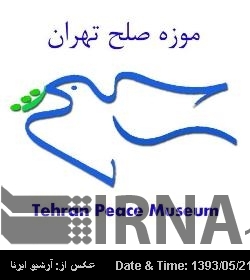Peace museums display war documents and things belonging to victims of weapons of mass destruction (WMDs) in the past 100 years.
Such museums seek to remind the harmful consequences of wars so that people help shape a world without war and violence.
Tehran Peace Museum was established in a building in Park-e Shahr (City Park) in 2007. It exhibits documents regarding the 1980-88 Iraq-imposed war against Iran and the use of chemical weapons by the Ba'athist regime against the Iranian army and civilians.
It is the first museum in Middle East that highlights the consequences of chemical weapons.
Founders of the museum are members of the Society for Supporting Chemical Weapons Victims. A number of war veterans and chemical warfare survivors also work in the museum.
Mohammad Reza Taqipour Moqaddam, who has lost both his legs and the right hand during the war for liberating Khorramshahr, runs the museums. He has been sitting in a wheelchair for the past 33 years.
Excerpts of the Wednesday edition of Iran Daily's interview with him follow:
IRAN DAILY: How was Tehran Peace Museum established?
TAQIPOUR MOQADDAM: The Society for Supporting Chemical Weapons Victims was launched as a non-governmental organization (NGO) for safeguarding the rights of chemical warfare survivors in 2003.
Tehran Peace Museum was launched in 2007.
A group of survivors of atomic bombings in Japan, who were members of an NGO, traveled to Iran in 2004 to prevent the use of weapons of mass destruction. They were also expected to travel to Pakistan and India.
At that time, a negative propaganda had been made against Iran. Many nations wrongly thought that Iran is seeking a nuclear weapon. However, they found out that Iran had also become a victim of WMDs and chemical weapons.
Since the Iraqi regime had used chemical weapons against Iran, Professor Peter van den Dungen, the head and general coordinator of the International Network of Museums for Peace, suggested that Iran could launch a peace museum. Tehran Mayor Mohammad Baqer Qalibaf welcomed the idea and allocated a building in Park-e Shahr for the museum.
Please explain the philosophy of establishing peace museums.
Peace museums show war atrocities that occurred in various countries. At least one weapon of mass destruction has been used in all these catastrophes and led to mass murder.
These museums promote the culture of peace and friendship. They want to say that war is not in the interest of any nation.
Which are the important peace museums worldwide?
The secretariat of the International Network of Peace Museums (INPM) is in The Hague. Currently, 150 peace museums are members of INPM, of which 50 belong to Japan.
Japan’s peace museums pertain to atomic bombardments of Hiroshima and Nagasaki by the US.
A peace museum is in Spain dates back to 77 years when Spanish dictator General Franco received help from the air forces of Germany and Italy to suppress his people and the Basque separatist group. They bombarded parts of Basque region, which claimed the lives of 1,000 people.
There is also a museum in Ypres, Belgium, which dates back to 100 years and World War I. The German Army used chemical weapons for the first time in that war. They put 6,000 pressurized cylinders and released chlorine gas when the wind was in the direction of the Allied forces. Many soldiers were killed and injured.
What's the global stance against chemical weapons?
Based on the Geneva Protocol (the Protocol for the Prohibition of the Use in War of Asphyxiating, Poisonous or other Gases, and of Bacteriological Methods of Warfare, 1925), Germany and other nations with chemical bombs did not use them in World War II.
Totally, close to 82 million people were killed during the two world wars. The United Nations was established two years after World War II.
Iraq’s Ba'athist regime used chemical weapons against Iran 63 years after the end of World War I. In fact, for the first time, Saddam used poisonous gas against the Iranian Army in Majnoon Island in 1984.
**1420

Tehran, Aug 12, IRNA -- Tehran Peace Museum is located in downtown Tehran.

